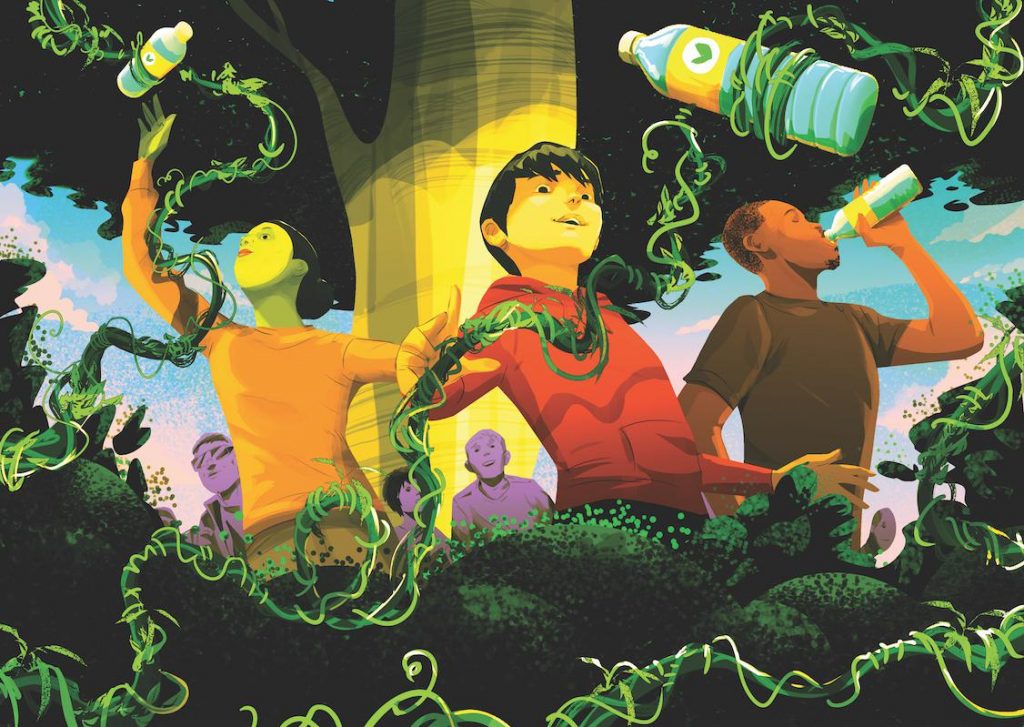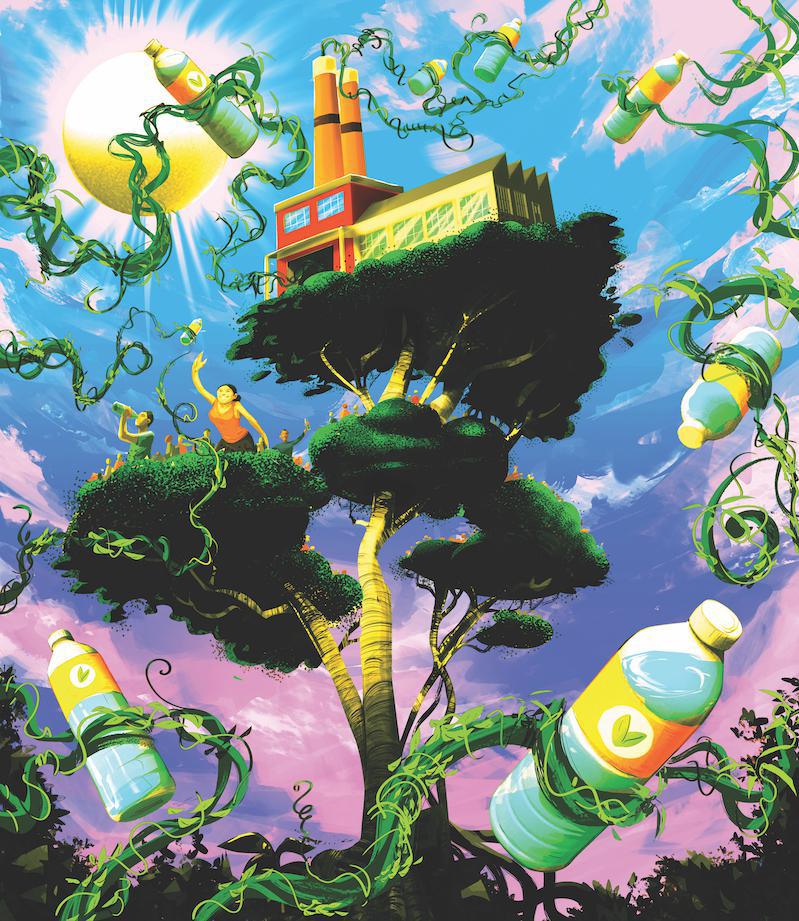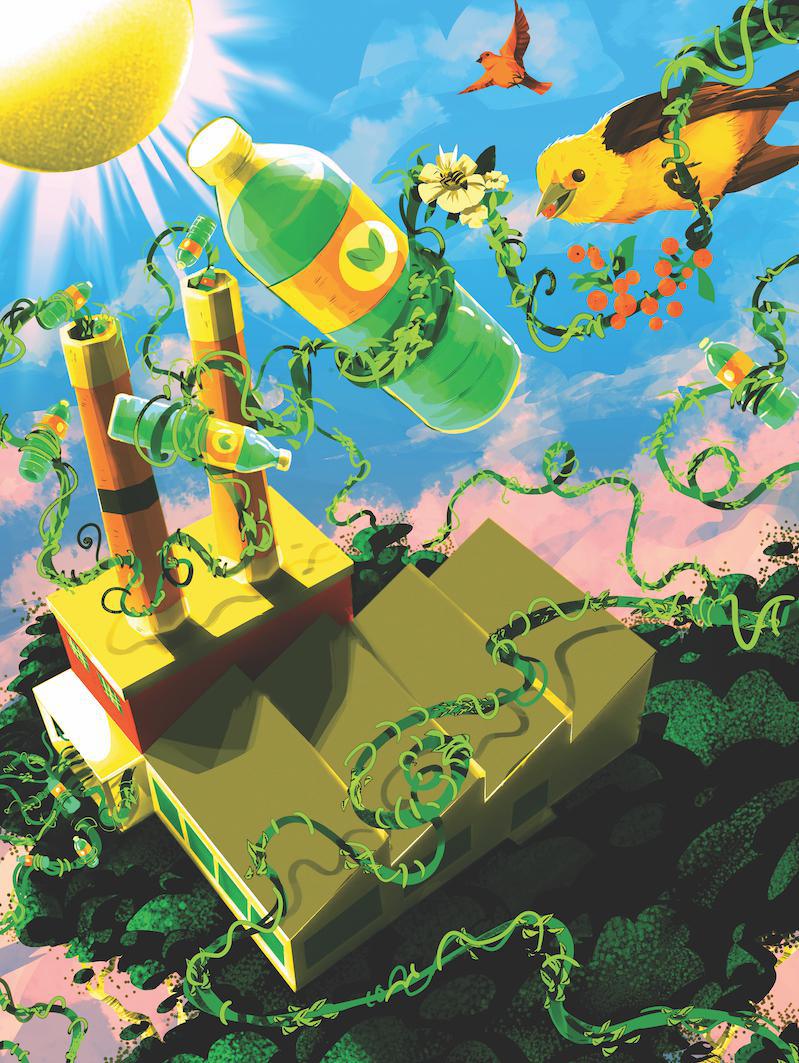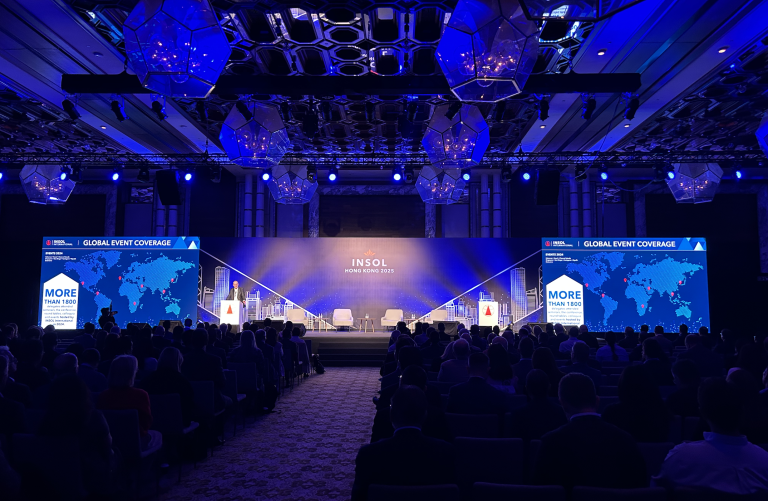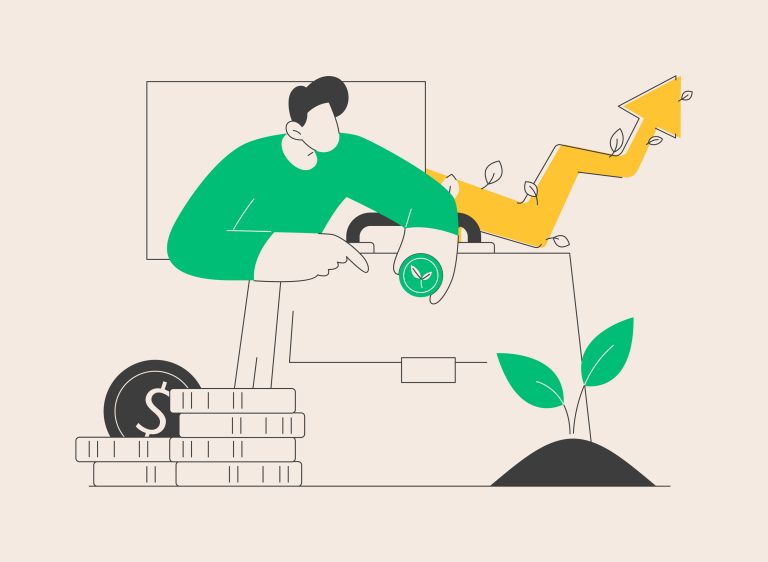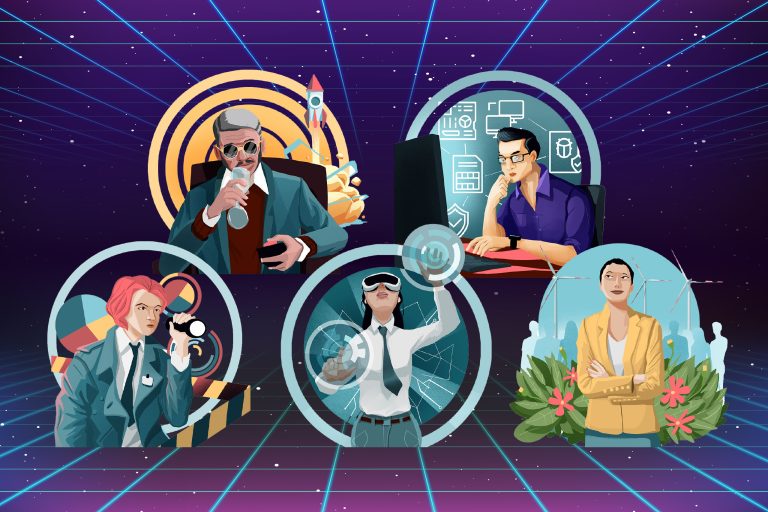A group of students at the Hong Kong University of Science and Technology (HKUST) were shocked by the amount of bread being thrown away by bakeries every day. During a night out in Lan Kwai Fong, they realized that because beer and bread both share the same fundamental ingredients – grain, water, yeast, and flavourings – it could be used to make beer. They persuaded a local bakery to give them its waste bread at the end of each day, and their start-up, Breer, was born.
The company is one of a growing number of companies in Hong Kong to embrace the circular economy.
Simon Ng, Chief Executive Officer of the Business Environment Council, explains: “The concept of the circular economy aims to redefine growth from a linear, take-make-waste system to one that decouples growth from the consumption of finite resources.” He adds that it aims to minimize the amount of raw material used and reduce the amount of waste being produced.
Benjamin Steuer, Assistant Professor, Division of Environment and Sustainability at HKUST, points out that the circular economy tries to eliminate waste by creating a closed loop system. “There is no waste; there are only secondary uses. In the ideal world of the circular economy, all products and components should be designed with the aim of preventing waste and preserving materials, so as to use them to their fullest extent,” he says.
Steuer adds that while recycling is the most frequently emphasized circular economy pattern, more emphasis should be placed on reducing consumption, and repairing, reusing and refurbishing existing items.
Lawrence Iu, Climate Change and Partnerships Lead at Civic Exchange, a Hong Kong-based public policy think tank, likens the circular economy to nature. He points out that the earth itself is a closed loop system, with the exception of energy coming in from the sun. “The sun gives us solar energy which plants use, through photosynthesis, to grow. Animals eat these plants and are eaten by other animals. When animals die, they decompose and their nutrients and minerals return to the earth and help plants to grow. This closed loop system is replicated in the circular economy,” he says.
Preserving resources
One of the key advantages of the circular economy is that it preserves resources. Helga Vanthournout, Founder of Wealth of Flows Consulting, explains that the circular economy tries either to create more value from a given set of resources, or use fewer resources to create the same amount of value or well-being.
Meike Sauerwein, a Lecturer at the Division of Environment and Sustainability at HKUST, points out that reusing and recycling materials not only preserves resources but also produces lower carbon emissions compared with extracting and creating new materials. “The extraction of resources and the processing of raw materials is highly intensive in terms of the energy, water and chemicals used. Reducing the volume of virgin materials that are needed for producing new products and extending the time that we can use existing products or materials saves a lot of resources.”
Another advantage of the circular economy is the cost savings it can create for businesses. Vanthournout says, “It is silly to take resources to create value and then let that value slip away from our economic system and from our physical environment. In the worst case, it creates environmental damage through littering and pollution and the use of uncontrolled dumps.” She adds that the benefits of adopting a circular approach can also be economic and societal, as under circular economy models, there is, for example, less migration of value-added work, which means more jobs are created locally.
Cyrus Cheung CPA (practising), Partner, ESG Services at PwC, and Deputy Chairman of the Hong Kong Institute of CPAs’ Sustainability Committee, says a circular economy will create opportunities for businesses. “There is job creation, such as under remanufacturing, and opportunities for innovation through technological development. Looking at this from a wider lens, a circular economy will also open opportunities for companies to build their competitive advantage, create new profit pools, strengthen resilience, and generate solutions to some of the most important challenges facing businesses today,” he says.
Ng adds that the adoption of circular principles and practices in business operations can also drive growth through the potential expansion into new markets, including repairs, remanufacturing, refurbishing, products-as-services or sharing economy markets. At the same time, it can lead to lower operating costs through reducing the level of resources used.
Overcoming barriers
Despite the many benefits of the circular economy, there are a number of barriers preventing its widespread adoption in Hong Kong. One of these is the city’s lack of space, particularly for the collection and recycling of materials.
Sauerwein gives the example of Germany, where bottle collection systems are common in supermarkets. She points out that because retailers in Hong Kong may lack the space for these systems, they would need to adopt different circular economy models. “There are work-arounds. People could bring their own bottles, or we could adopt rental and reuse systems for many different types of products,” she says.
Vanthournout points out that Hong Kong’s lack of space could also be an advantage, as the city has one of the most important assets that a well-functioning circular economy requires – a high density of people and infrastructure, ranging from buildings to transportation, as well as consumer goods.
She adds that people in Hong Kong are also already used to and particularly adept at sharing infrastructure, such as public transport and communal space. “They are clever at doing this in entrepreneurial ways. Many businesses and initiatives could not thrive without use of the commons,” she says.
Cheung thinks another barrier to the take up of the circular economy in Hong Kong is a lack of awareness among consumers of the impact of the “take-make-waste” approach – where raw materials are collected and then transformed into products that are used until they are finally discarded as waste – combined with a reluctance to make behavioural changes.
Ng agrees: “In Hong Kong, the crucial impediment is inadequate understanding and awareness of circular economy concepts including design, repair, reuse, refurbishment and remanufacturing in the business sector. Hong Kong’s service-based economic structure and the lack of diverse industries also lead to a recycling gap in the city, as there is a shortfall in demand and use for recycled materials.”
He adds that to overcome these barriers, the government needs to introduce more incentives to promote circular economy concepts in Hong Kong, develop plans for recycled materials to be used in production and construction, and introduce regulations on eco-packaging.
Iu thinks the economics of the circular economy are also challenging for some sectors. He gives the example of a scheme to convert waste cooking oil in Hong Kong into biodiesel. “The problem is that the collection fee for the waste cooking oil is very high, which discourages the use of it for manufacturing biodiesel, as the price of biodiesel is not high enough to make it worthwhile.”
Steuer thinks the biggest barrier in Hong Kong is a lack of regulation and strategy that encourages the circular economy, such as standards on recycling or taxation on products headed for the landfill and an action plan with binding target rates for the circular economic indicators.
He adds that although the government has subsidies for enterprises involved in certain activities, such as recycling, the schemes are designed for companies that have a strong administrative capacity and can be difficult for smaller companies to access. “What we have learned from other cases globally is that companies that engage in circular economy patterns of refurbishment and repair are small and medium enterprises (SMEs). We have these SMEs in Hong Kong, but they don’t have the capacity to apply for funding. We need to offer more targeted support,” he says.
“An evaluation of the supply chain and operations can shed light on opportunities to strengthen resilience.”
Making the transition
For businesses that would like to adopt circular economy practices in their own activities, Steuer suggests them to start by looking at the waste they generate and the cost of disposal. They should then think about how they can reduce this waste, replace waste-intense feedstock or inputs with more sustainable and cheaper alternatives, or whether another company could actually use the generated waste for its production. A lot is about material synergies, material substitution and rendering waste into production inputs, he says.
“Another approach is to do a material flow analysis, looking at what goes into a company and what comes out. First look at the input side, i.e. the type of materials used, and whether these raw materials could be replaced with alternatives, such as recycled plastic or in the case of packaging, more sustainable paper-based products. Then look at the output side, that is the products and waste that result from the production process. Identify whether products are overly resource-intensive or could be made cheaper through better design and less material input, and whether any waste materials could be sold on,” he says.
Cheung suggests companies should adopt a three-step process, beginning with a review of the materials they use, including energy, electronics, water and food. “Firstly, an evaluation of the supply chain and operations can shed light on opportunities to strengthen resilience,” he adds. Next, he suggests companies should set targets that are relevant to their business, and thirdly, engaging with suppliers to find products and services that are designed to enable the circular economy.
Ng says: “Companies need to examine the potential opportunities within the context of their businesses and operations. This will help them better understand how they can optimize and enhance their structures and systems to capitalize on the circular economy.” Organizations, Ng adds, should also look at which circular business models could be best integrated into their business structure. For example, the use of circular supplies, resource recovery, product life extension, the use of sharing platforms, or the transformation of products as a service.
Iu urges companies adopting a circular economy approach to train and educate their employees on its importance. Vanthournout agrees: “The circular economy is a perspective. People working across different functions need to understand its mechanisms and be inspired to adopt them in their daily work so that it becomes part of everything else they are doing.”
She adds that companies should also examine where value is lost and how they can recapture that value. Vanthournout gives the example of a company that was part of a recycling programme to prevent its materials ending up in a landfill. “That was great, but there was still a value loss because those materials were important to them and they ended up in the commodity market. Instead, they could try to create a more proprietary recycling scheme so that those materials end up back with them again,” she explains.
Another example is breweries that commonly recover spent gain but sell it on for low-end, low-value uses. Vanthournout says they could instead be looking to make high-end products out of it, such as fish feed.
“If you are familiar with the different loops and the different levers that you can apply in a circular economy model, then you can systematically identify and address those value losses,” she says.
Adapting financial models
New financial models are being developed to help companies make the transition to circular business models. Known as circular economy finance, or circular finance, Cheung explains that these are financial instruments that integrate circular economy factors into business decisions, to help enable companies to transition to a circular economy.
But Vanthournout points out that there is still a lack of understanding about how the risk profile of a business changes when it goes circular. “If there is no understanding and appreciation of this change, then these businesses cannot access financing at the right price,” she says.
She notes that circular economy models often de-risk a company’s downstream, as they move from being involved in one-off transactions to a set of ongoing relationships in which they offer services. These create ongoing revenue streams, greatly increasing the opportunity to maximize lifetime customer value. “Financial institutions need to understand that and put a number on it,” Vanthournout says.
Financial institutions also need to understand new business models arising out of the circular economy. Vanthournout gives the example of leasing companies that typically only have one leasing cycle for an asset before selling it off. “If they are good at assessing the wear and tear of the asset, they can create multiple leases to different markets from the same asset,” she says.
Ng suggests that governments should do more to encourage investment in the circular economy by directly investing in circular activities and technologies themselves. “Regulators can also look into standardizing definitions and metrics on circular activities and heighten the need for proper and greater disclosure among the private sector. These measures will enhance the transparency, consistency and quality of data on circular performances,” he says.
“Traditionally, you buy resources and produce products, and as soon as the sale materializes it moves off your books. In a circular economy, some of that will come back, either in the form of raw material if you are recycling, in the form of parts, or in the form of entire products.”
The role of accountants
Accountants and other finance professionals have an important role to play in helping companies transition to a circular economy.
Vanthournout thinks accountants have a role to play in developing new accounting models to better track products and resources across their entire lifecycle. “Traditionally, you buy resources and produce products, and as soon as the sale materializes it moves off your books. In a circular economy, some of that will come back, either in the form of raw material if you are recycling, in the form of parts, or in the form of entire products, but existing accounting systems are not set up to keep these products linked to your company,” she explains.
Steuer thinks accountants can also help companies conduct material flow assessments, and understand where waste is being generated and how the whole process could be improved. Sauerwein adds that they can also identify which materials have a higher impact on the environment, such as looking at where these materials come from, how they were processed, and what happens to them once the company has finished with them.
Iu thinks accountants can also play a role in helping companies develop better disclosure systems, not only in the area of finance but also for waste and performance disclosure. “If corporates have more transparency, it is a game-changer,” he says. Cheung agrees, noting that knowledge in creating value within a circular economy and how to mitigate related risks will be in greater demand, especially as finance departments at pioneering companies develop tools that can identify which of the many potential circular models and practices would be relevant and beneficial to their organization. “These assessments call for analytical, modelling, and business forecasting skills, and these demands match the skill sets accountants and finance professionals hold, and the roles they can play,” he says.
A circular economy is a systemic approach to economic development designed to benefit businesses, society, and the environment. In contrast to the “take-make-waste” linear model, a circular economy is regenerative by design and aims to gradually decouple growth from the consumption of finite resources, according to the charity, the Ellen MacArthur Foundation.






